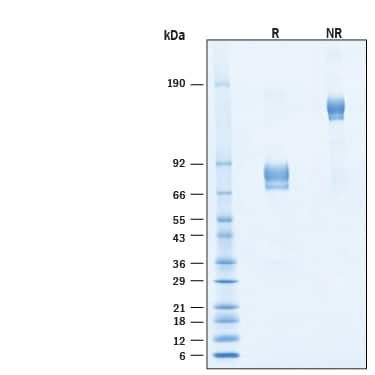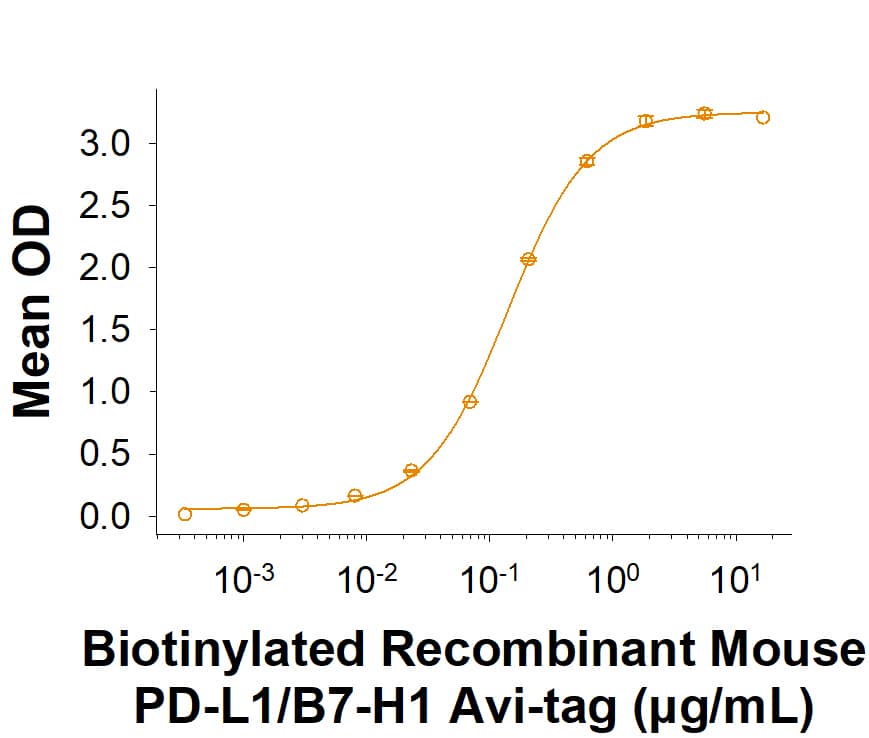Recombinant Mouse PD-L1/B7-H1 Fc Chimera Avi-tag Protein, CF
R&D Systems, part of Bio-Techne | Catalog # AVI1019

Key Product Details
Learn more about Avi-tag Biotinylated Proteins
Source
CHO
Accession #
Structure / Form
Biotinylated via Avi-tag
Conjugate
Biotin
Applications
Bioactivity
Product Specifications
Source
Chinese Hamster Ovary cell line, CHO-derived mouse PD-L1/B7-H1 protein
| Mouse B7-H1 (Phe19-Thr238) Accession # Q9EP73.1 |
IEGRMD | Human IgG1 (Pro100-Lys330) |
Avi-tag |
| N-terminus | C-terminus | ||
Purity
>90%, by SDS-PAGE visualized with Silver Staining and quantitative densitometry by Coomassie® Blue Staining.
Endotoxin Level
<0.10 EU per 1 μg of the protein by the LAL method.
N-terminal Sequence Analysis
Phe19
Predicted Molecular Mass
53 kDa
SDS-PAGE
67-85 kDa, under reducing conditions.
Activity
Measured by its binding ability in a functional ELISA.
When Recombinant Mouse PD-1 Fc Chimera Protein (Catalog # 1021-PD) is immobilized at 2.50 μg/mL (100 μL/well), Biotinylated Recombinant Mouse PD-L1/B7-H1 Fc Chimera Avi-tag (Catalog # AVI1019) binds with an ED50 of 0.0600-0.600 μg/mL.
When Recombinant Mouse PD-1 Fc Chimera Protein (Catalog # 1021-PD) is immobilized at 2.50 μg/mL (100 μL/well), Biotinylated Recombinant Mouse PD-L1/B7-H1 Fc Chimera Avi-tag (Catalog # AVI1019) binds with an ED50 of 0.0600-0.600 μg/mL.
Scientific Data Images for Recombinant Mouse PD-L1/B7-H1 Fc Chimera Avi-tag Protein, CF
Biotinylated Recombinant Mouse PD-L1/B7-H1 Fc Chimera Avi-tag Protein Binding Activity.
Measured by its binding ability in a functional ELISA. When Recombinant Mouse PD-1 Fc Chimera Protein (1021-PD) is immobilized at 2.5 μg/mL (100 μL/well), Biotinylated Recombinant Mouse PD-L1/B7-H1 Fc Chimera Avi-tag Protein (Catalog # AVI1019) binds with an ED50 of 0.0600-0.600 μg/mL.Biotinylated Recombinant Mouse PD-L1/B7-H1 Fc Chimera Avi-tag Protein SDS-PAGE.
2 μg/lane of Biotinylated Recombinant Mouse PD-L1/B7-H1 Fc Chimera Avi-tag Protein (Catalog # AVI1019) was resolved with SDS-PAGE under reducing (R) and non-reducing (NR) conditions and visualized by Coomassie® Blue staining, showing bands at 67-85 kDa and 130-170 kDa, respectively.Formulation, Preparation and Storage
AVI1019
| Formulation | Lyophilized from a 0.2 μm filtered solution in PBS with Trehalose. |
| Reconstitution | Reconstitute at 250 μg/mL in PBS. |
| Shipping | The product is shipped at ambient temperature. Upon receipt, store it immediately at the temperature recommended below. |
| Stability & Storage | Use a manual defrost freezer and avoid repeated freeze-thaw cycles.
|
Background: PD-L1/B7-H1
References
- Ceeraz, S. et al. (2013) Trends Immunol. 34:556.
- Tamura, H. et al. (2001) Blood 97:1809.
- Chen, L. et al. (2007) J. Immunol. 178:6634.
- Kuang, D.-M. et al. (2014) J. Clin. Invest. 124:4657.
- Tsushima, F. et al. (2007) Blood 110:180.
- Mazanet, M.M. and C.C.W. Hughes (2002) J. Immunol. 169:3581.
- Cao, Y. et al. (2010) Cancer Res. 71:1235.
- Scandiuzzi, L. et al. (2014) Cell Rep. 6:625.
- Dong, H. et al. (2002) Nat. Med. 8:793.
- Azuma, T. et al. (2008) Blood 111:3635.
- Butte, M.J. et al. (2008) Mol. Immunol. 45:3567.
- Park, J.-J. et al. (2010) Blood 116:1291.
- Ritprajak, P. et al. (2010) J. Immunol. 184:4918.
- Herold, M. et al. (2015) J. Immunol. 195:3584.
Long Name
Programmed Death Ligand 1
Alternate Names
B7-H1, B7H1, CD274, PDCD1L1, PDCD1LG1, PDL1
Entrez Gene IDs
Gene Symbol
CD274
UniProt
Additional PD-L1/B7-H1 Products
Product Documents for Recombinant Mouse PD-L1/B7-H1 Fc Chimera Avi-tag Protein, CF
Product Specific Notices for Recombinant Mouse PD-L1/B7-H1 Fc Chimera Avi-tag Protein, CF
For research use only
